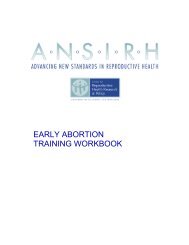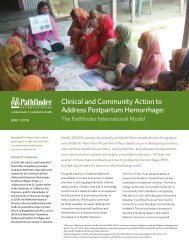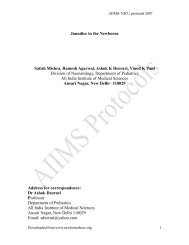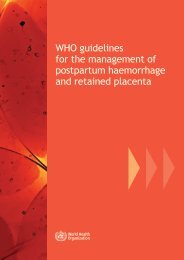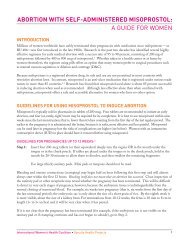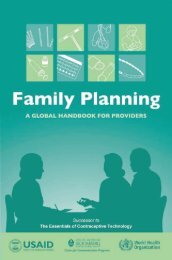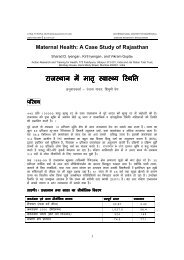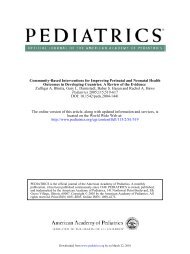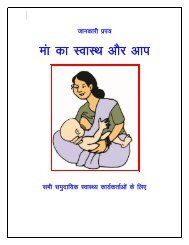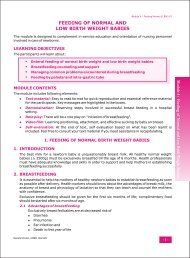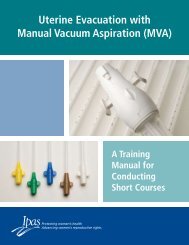Gender Gaps in Research on Abortion in India - CommonHealth
Gender Gaps in Research on Abortion in India - CommonHealth
Gender Gaps in Research on Abortion in India - CommonHealth
You also want an ePaper? Increase the reach of your titles
YUMPU automatically turns print PDFs into web optimized ePapers that Google loves.
that the reas<strong>on</strong>s may not be so simple.<br />
<str<strong>on</strong>g>Research</str<strong>on</strong>g> gaps<br />
Why do women opt not to use c<strong>on</strong>tracepti<strong>on</strong> and rely <strong>on</strong> aborti<strong>on</strong>s <str<strong>on</strong>g>in</str<strong>on</strong>g>stead? This is a questi<strong>on</strong> that<br />
c<strong>on</strong>t<str<strong>on</strong>g>in</str<strong>on</strong>g>ues to baffle those attempt<str<strong>on</strong>g>in</str<strong>on</strong>g>g to understand the reproductive behaviour and choices of women<br />
<str<strong>on</strong>g>in</str<strong>on</strong>g> <strong>India</strong>.<br />
The c<strong>on</strong>text with<str<strong>on</strong>g>in</str<strong>on</strong>g> which women make choices related to fertility regulati<strong>on</strong> may be the key to this<br />
puzzle. The fact that many women undergo<str<strong>on</strong>g>in</str<strong>on</strong>g>g aborti<strong>on</strong>s had used c<strong>on</strong>traceptives at some po<str<strong>on</strong>g>in</str<strong>on</strong>g>t <str<strong>on</strong>g>in</str<strong>on</strong>g> their<br />
reproductive lives suggests that women may be us<str<strong>on</strong>g>in</str<strong>on</strong>g>g both c<strong>on</strong>tracepti<strong>on</strong> and aborti<strong>on</strong> as strategies for<br />
fertility regulati<strong>on</strong>, us<str<strong>on</strong>g>in</str<strong>on</strong>g>g <strong>on</strong>e or the other depend<str<strong>on</strong>g>in</str<strong>on</strong>g>g <strong>on</strong> the situati<strong>on</strong> at hand. As seen from <strong>on</strong>e study,<br />
women's n<strong>on</strong>-use of c<strong>on</strong>tracepti<strong>on</strong> is likely <str<strong>on</strong>g>in</str<strong>on</strong>g> many situati<strong>on</strong>s to be dictated by their husbands'<br />
preferences and attitudes to c<strong>on</strong>tracepti<strong>on</strong>. Women may be forced to disc<strong>on</strong>t<str<strong>on</strong>g>in</str<strong>on</strong>g>ue c<strong>on</strong>tracepti<strong>on</strong> because<br />
of this, and when they get pregnant, have an <str<strong>on</strong>g>in</str<strong>on</strong>g>duced aborti<strong>on</strong> if possible, or c<strong>on</strong>t<str<strong>on</strong>g>in</str<strong>on</strong>g>ue with the<br />
pregnancy and then have sterilisati<strong>on</strong>. The role of <str<strong>on</strong>g>in</str<strong>on</strong>g>timate partner violence <str<strong>on</strong>g>in</str<strong>on</strong>g> women's ability to use<br />
c<strong>on</strong>tracepti<strong>on</strong> and avoid an unwanted pregnancy is also an area that has not received any attenti<strong>on</strong> <str<strong>on</strong>g>in</str<strong>on</strong>g><br />
the studies reviewed.<br />
To be able to understand the underly<str<strong>on</strong>g>in</str<strong>on</strong>g>g factors and compulsi<strong>on</strong>s that result <str<strong>on</strong>g>in</str<strong>on</strong>g> women's reliance <strong>on</strong><br />
<str<strong>on</strong>g>in</str<strong>on</strong>g>duced aborti<strong>on</strong> to space or limit births requires <str<strong>on</strong>g>in</str<strong>on</strong>g>-depth qualitative studies that document women's<br />
reproductive histories with<str<strong>on</strong>g>in</str<strong>on</strong>g> the c<strong>on</strong>text of their social situati<strong>on</strong> and of the gender-power dynamics <str<strong>on</strong>g>in</str<strong>on</strong>g><br />
their marital relati<strong>on</strong>ship. It is important to <str<strong>on</strong>g>in</str<strong>on</strong>g>clude husbands as study participants and document their<br />
role <str<strong>on</strong>g>in</str<strong>on</strong>g> decisi<strong>on</strong>s perta<str<strong>on</strong>g>in</str<strong>on</strong>g><str<strong>on</strong>g>in</str<strong>on</strong>g>g to fertility regulati<strong>on</strong>.<br />
Pre and post aborti<strong>on</strong> c<strong>on</strong>traceptive behaviour of s<str<strong>on</strong>g>in</str<strong>on</strong>g>gle women seek<str<strong>on</strong>g>in</str<strong>on</strong>g>g aborti<strong>on</strong>, and barriers to their<br />
use of c<strong>on</strong>tracepti<strong>on</strong> is another area that needs to be better understood.<br />
Health outcomes of an <str<strong>on</strong>g>in</str<strong>on</strong>g>duced aborti<strong>on</strong> 13<br />
Despite the legalisati<strong>on</strong> of aborti<strong>on</strong> <str<strong>on</strong>g>in</str<strong>on</strong>g> 1971, mortality and morbidity related to aborti<strong>on</strong> rema<str<strong>on</strong>g>in</str<strong>on</strong>g>ed high<br />
even <str<strong>on</strong>g>in</str<strong>on</strong>g>to the late 1990s. Most of these resulted from unsafe aborti<strong>on</strong>s performed by unlicensed<br />
physicians and other untra<str<strong>on</strong>g>in</str<strong>on</strong>g>ed practiti<strong>on</strong>ers.<br />
Accord<str<strong>on</strong>g>in</str<strong>on</strong>g>g to model registrati<strong>on</strong> data <strong>on</strong> causes of death <str<strong>on</strong>g>in</str<strong>on</strong>g> rural <strong>India</strong>, aborti<strong>on</strong> accounted for about<br />
11-12% of all maternal deaths dur<str<strong>on</strong>g>in</str<strong>on</strong>g>g 1978-1990, a period when aborti<strong>on</strong>s were legal and available <str<strong>on</strong>g>in</str<strong>on</strong>g><br />
government health facilities free of cost (3). Dur<str<strong>on</strong>g>in</str<strong>on</strong>g>g 1991-94, age-specific mortality related to aborti<strong>on</strong><br />
was highest am<strong>on</strong>g women <str<strong>on</strong>g>in</str<strong>on</strong>g> the 20-24 year age group <str<strong>on</strong>g>in</str<strong>on</strong>g> rural <strong>India</strong> (5).<br />
An <str<strong>on</strong>g>in</str<strong>on</strong>g>stituti<strong>on</strong>-based ICMR study <str<strong>on</strong>g>in</str<strong>on</strong>g> the 1980s noted that aborti<strong>on</strong> as a proporti<strong>on</strong> of maternal deaths <str<strong>on</strong>g>in</str<strong>on</strong>g><br />
<str<strong>on</strong>g>in</str<strong>on</strong>g>stituti<strong>on</strong>s had rema<str<strong>on</strong>g>in</str<strong>on</strong>g>ed at around 20% dur<str<strong>on</strong>g>in</str<strong>on</strong>g>g the 1970s and 1980s (5).<br />
Informati<strong>on</strong> from studies <strong>on</strong> morbidity follow<str<strong>on</strong>g>in</str<strong>on</strong>g>g an aborti<strong>on</strong> procedure is often based <strong>on</strong> recall and their<br />
reliability may vary depend<str<strong>on</strong>g>in</str<strong>on</strong>g>g <strong>on</strong> the sample. Where the sample <str<strong>on</strong>g>in</str<strong>on</strong>g>cludes <strong>on</strong>ly women who have had a<br />
recent aborti<strong>on</strong> experience, recall may be better than <str<strong>on</strong>g>in</str<strong>on</strong>g> studies where the sample <str<strong>on</strong>g>in</str<strong>on</strong>g>cludes all women<br />
who have ever had an aborti<strong>on</strong>. Health facility based studies that document immediate post-aborti<strong>on</strong><br />
morbidity may not have recall errors but are based <strong>on</strong> a self-selected sample. Aborti<strong>on</strong> morbidity data<br />
have to be <str<strong>on</strong>g>in</str<strong>on</strong>g>terpreted keep<str<strong>on</strong>g>in</str<strong>on</strong>g>g these limitati<strong>on</strong>s <str<strong>on</strong>g>in</str<strong>on</strong>g> m<str<strong>on</strong>g>in</str<strong>on</strong>g>d.<br />
In rural Maharashtra (10), there were 1396 episodes of morbidity <str<strong>on</strong>g>in</str<strong>on</strong>g> 1492 women who had underg<strong>on</strong>e<br />
13. The follow<str<strong>on</strong>g>in</str<strong>on</strong>g>g studies fall under this secti<strong>on</strong>: Reference numbers 3, 5, 10, 24, 28, 29, 30, 33, 34, 35, 36, 72, 76.<br />
15



